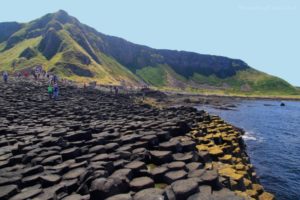
The fourth and final golf major of the year takes place on 18th to 21st July. Portrush in Northern Island has been chosen to host the sport’s oldest and most prestigious tournament. Here we look at the history of the course, what makes it so special, and who is looking to make an impression there this July.
Portrush the Town and the Course
The small town of Portrush is home to approximately six thousand inhabitants and is situated in County Antrim on the northern coast of Northern Ireland (Ulster). It dates back to the twelfth century, but archaeological remains suggest that there was a settlement on the site as long ago as 4000 BC. The town is known for two things, namely its picturesque, sandy beaches and, of course, its golf course.
Portrush Golf Course holds the distinction of being the only course to have hosted the Open Championship outside of England and Scotland. Originally built in 1888 as a 9-hole course, it underwent several changes in its first half dozen years. First it was extended to 18 holes, then it changed its name from The County Club to The Royal County Club and then, finally, to The Royal Portrush Golf Club. His Royal Highness The Prince of Wales, who would later become King Edward VII, was the club’s patron.
Ireland’s first professional tournament was held at the course in 1895. That same year it also hosted the British Ladies Championship, an event that has returned seven times since. After the Irish Open graced Portrush in 1930, 1937 and 1947, it really came to the golfing world’s attention in 1951 when it opened its gates to The Open. Max Faulkner won by two strokes with a score of 285, in what would be his only major success.
The Dunluce Links—the official title of the course The Open is played upon—is regarded as not just one of the most picturesque links, but also as one of the most challenging. Whoever is leading the scoreboard on the evening of the 21st July will have certainly earned his victory.
Every hole presents its own challenges (as does the weather, even in the heart of summer), but there are a few that jump out. The fourth is a par 4 that plays every inch of its 480 yards from the championship tees. Out of bounds looms on the right of the fairway, while to the left is thick rough that can eat up scores and balls aplenty. Even if you find the short grass, you are not safe. The fairway undulates and can carry your drive into any one of the numerous bunkers. Hitting onto the green requires precision due to the strategically-positioned sand hills that guard it.
At first glance the fifth looks like it may offer relief to those who suffered on the previous hole. The par four is fairly short, and you hit downhill into the dogleg right. There are also no bunkers. However, the green undulates heavily, and even worse, drops steeply away down to the beach. The views are stunning, but that will be the last thing on the players’ minds as their balls gather pace before disappearing into the sand at the bottom of the cliff.
The most notorious of them all, though, is the sixteenth. Calamity Corner, or simply “Calamity” as the locals term it, is a 236-yard par three. It is uphill, which makes it seem a lot longer, and a massive ravine cuts across the fairway in front of the green to the right. Behind and to the left you are not safe, with a nightmare collection of hollows and mounds.
This Year’s Open
The 148th Open will be as fiercely-contested as they come, with almost all of the big players hitting form at the right time. The people at Oddschecker provide a thorough breakdown of the runners and riders leading up to the event. U.S. golfers have won 9 of the last 11 majors, with Brooks Koepka picking up three of them (plus one the previous year). With their tight fairways and less reliance on yards off the tee, the links courses used for The Open tend to play more into the hands of the European golfers. In the last 12 years, the winner of the claret jug has come from these shores just four times.
It is no surprise that (barring injury) Koepka will tee off on the first in County Antrim as the strong favorite. Koepka, from West Palm Beach, has been either first or second in the last five majors. He also likes playing in the UK and has finished in the top 10 twice in his last three Opens. Finally, he will have some invaluable local knowledge in the form of his caddie Ricky Elliott. Ricky grew up in Portrush and knows the course very well.
You can’t discount Tiger. After his incredible victory at this year’s Masters, he never really got going at Pebble Beach, but he will definitely be targeting his fourth Open win. Dustin Johnson was another player who disappointed at Pebble Beach and will be looking to make amends at Portrush. The European challenge is likely to be led by Justin Rose, who was challenging in the U.S. Open until the last few holes, and Ulsterman Rory McIlroy.

The Open is one of the oldest, and still one of most eagerly-awaited, sporting spectacles on the planet. The PGA has done well with its choice of course, as well. The Dunluce Links may not be a Rancho Vista Golf Club, but it is just as stunning to walk and watch as it is demanding to play. It also brings people and attention to an incredible, but often forgotten, part of the world. For those considering making the trip over to Northern Ireland, that stretch of coast is one of the most dramatic and charming anywhere. As well as the beaches in and around Portrush itself, the Giant’s Causeway, one of the world’s most famous and unusual natural geological structures, is less than 10 miles away along the cliffs.
Author: Maria Drozdova
–